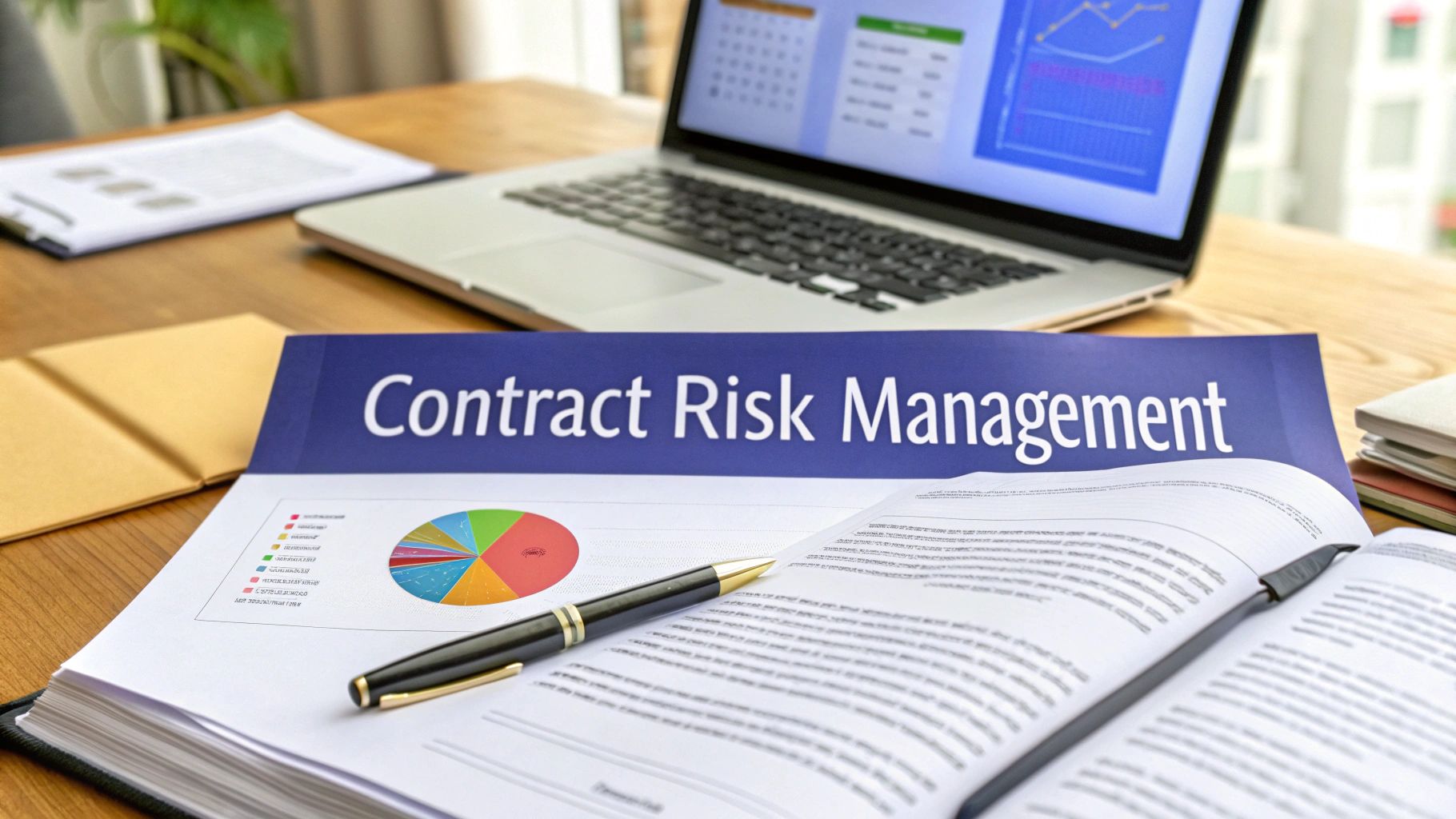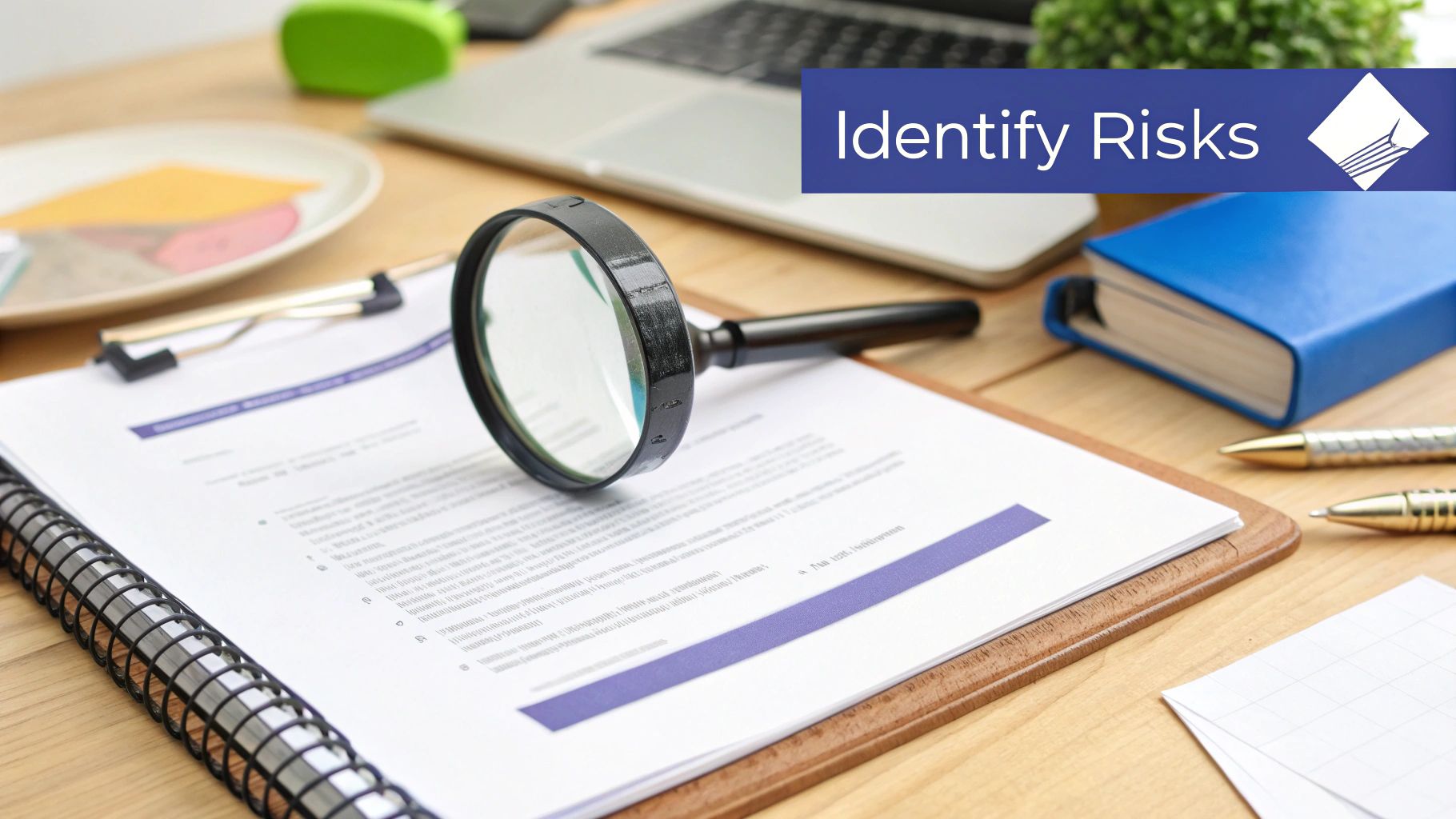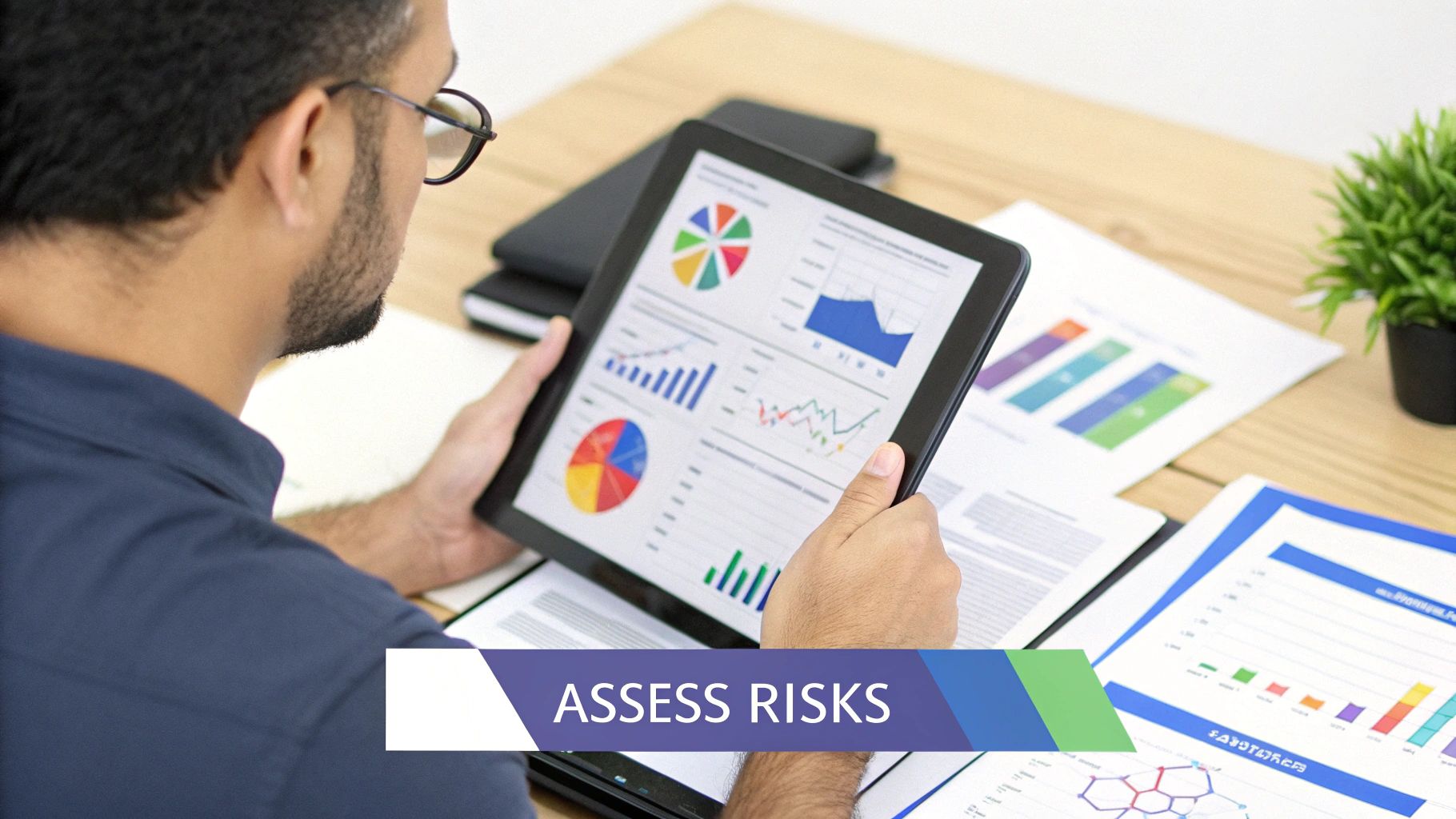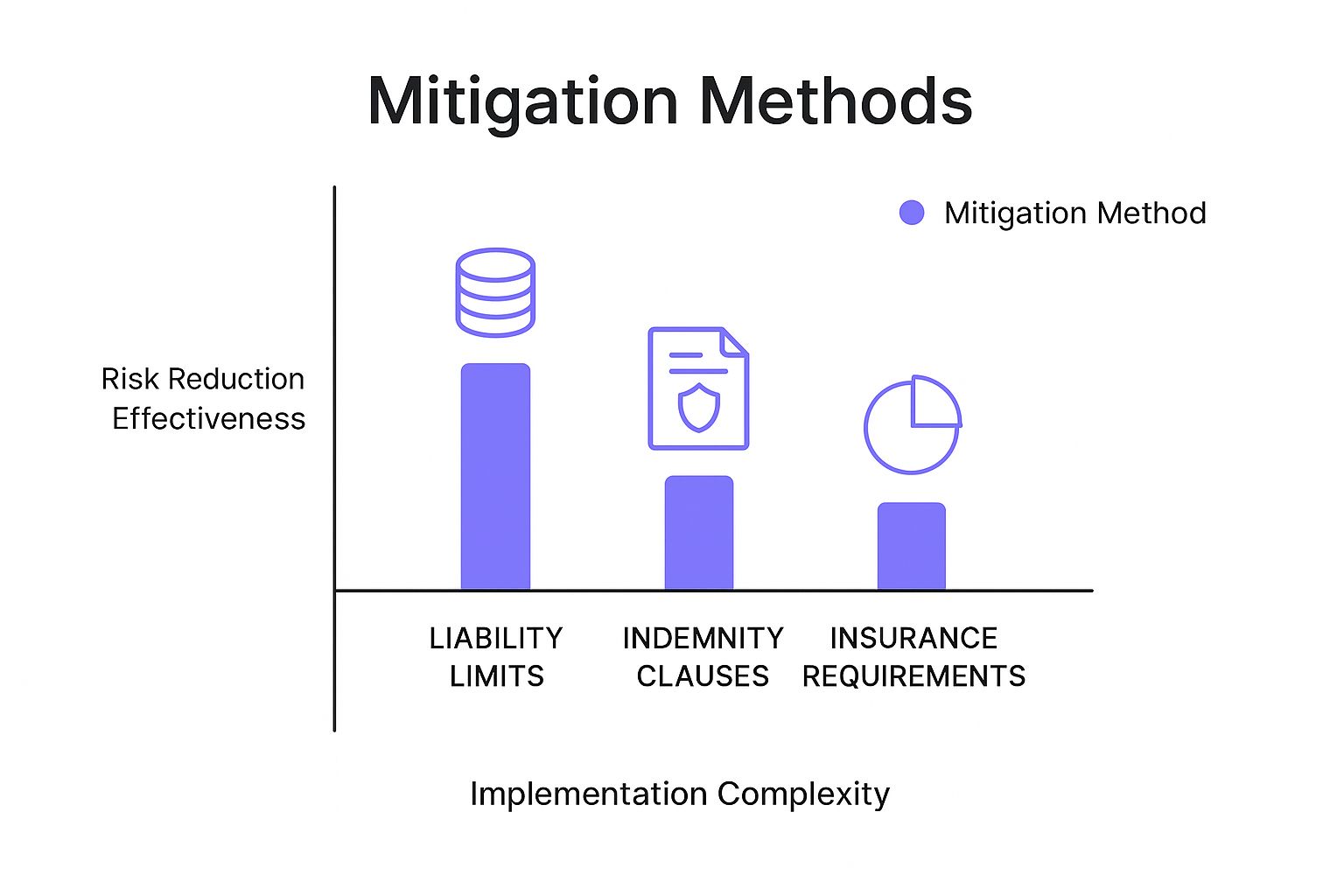
Navigating the Contract Risk Landscape
Managing contract risk is crucial for protecting your business. It's not just about administration; it's about proactive safeguards and ensuring sustainable growth. This means understanding the changing nature of risk in today's interconnected business world and creating strategies to mitigate potential threats. Ignoring contract risk can expose your organization to various negative outcomes, from financial losses to reputational damage.
Understanding the Importance of Contract Risk Management
Effective contract risk management is vital for several reasons. First, it helps organizations avoid financial penalties due to non-compliance. Second, a robust contract risk management process minimizes operational disruptions caused by vendor failures or contract disputes. Finally, it protects a company's reputation by ensuring ethical and legal conduct in all agreements. To gain a deeper understanding, explore proven strategies for software development risk management. This resource offers valuable insights into protecting your projects.
The Evolving Landscape of Contract Risk
The business world is constantly changing, and so are the risks tied to contracts. Globalization, technological advances, and increased regulatory scrutiny add to the complexity of contract risk management. The growing reliance on third-party vendors adds another layer, as organizations must manage risks within their extended network. This requires businesses to take a more dynamic and proactive approach to contract risk management to stay ahead of potential issues.
For instance, the rise of cloud-based services brings new risks related to data security and privacy. Also, global market fluctuations can impact vendor financial stability, potentially disrupting supply chains. These evolving risks demand that organizations continually assess and adapt their contract risk management process. The financial impact of poor contract management is substantial. Ineffective practices can cost companies 9.2% of annual revenue and diminish a contract's potential value by 40%. See more detailed statistics here.
Key Components of a Robust Contract Risk Management Process
A robust contract risk management process includes several key components:
Risk Identification: Pinpointing potential risks associated with each contract, such as vendor financial instability, legal non-compliance, and operational failures.
Risk Assessment: Evaluating the probability and potential impact of each identified risk.
Risk Mitigation: Creating strategies to reduce or eliminate the identified risks, such as adding specific clauses to contracts or implementing monitoring protocols.
Risk Monitoring: Continuously tracking contracts for new risks and assessing the effectiveness of mitigation strategies.
By implementing a comprehensive contract risk management process, organizations can proactively safeguard their interests, minimize potential losses, and ensure sustainable growth.
Building Your Contract Risk Management Framework

A solid contract risk management framework is more than just having templates. It's the foundation of effective contract governance. This framework provides the structure and processes you need to identify, assess, and mitigate risks throughout the contract lifecycle. This means creating a system that supports your business goals and protects your interests.
Establishing Risk Thresholds and Assessment Methodologies
A crucial first step is defining your organization's risk appetite. This means determining the level of risk your organization is willing to accept. This sets the boundaries for your contract risk management efforts. For example, a startup might accept more risk than a large, established company.
You also need standardized assessment methodologies. These provide consistent criteria for evaluating contracts, regardless of their type or value. This consistency helps ensure fair and efficient evaluation of all contracts. Standardized procedures also simplify training and make the entire process more efficient.
Fostering Cross-Functional Collaboration
Effective contract risk management requires collaboration across different departments. Legal, procurement, and compliance teams all play crucial roles. This collaborative approach ensures everyone's perspective is considered. But it’s important to avoid creating bottlenecks. Clear communication and defined roles are essential for smooth cross-functional teamwork. This involves establishing clear lines of responsibility and authority.
When building your contract risk management framework, think about how it fits within your overall business compliance strategy. For further reading, explore these effective compliance risk management strategies.
Developing Protective Contract Templates
A comprehensive framework is essential, but well-crafted contract templates are still a vital tool. These templates act as the starting point for all agreements, using pre-approved clauses that mitigate common risks. This proactive approach reduces the need for extensive revisions later. This allows for flexibility while protecting your organization's core interests. For example, including clauses that address force majeure or data breaches can provide significant protection in uncertain times.
To better understand the core components and their respective stakeholders, take a look at the table below:
This table outlines the essential elements of a contract risk management process, highlighting the key stakeholders responsible for each component.
| Component | Description | Primary Stakeholders | Implementation Priority |
|---|---|---|---|
| Risk Identification | Pinpointing potential contractual risks throughout the contract lifecycle. | Legal, Procurement, Business Units | High |
| Risk Assessment | Evaluating the likelihood and potential impact of identified risks. | Legal, Procurement | High |
| Risk Mitigation | Developing strategies to reduce or eliminate contractual risks. | Legal, Procurement, Business Units | High |
| Contract Template Development | Creating standardized templates with pre-approved clauses to mitigate common risks. | Legal, Procurement | Medium |
| Training and Communication | Educating stakeholders on contract risk management policies and procedures. | Legal, Procurement | Medium |
| Monitoring and Review | Regularly assessing the effectiveness of the framework and making necessary adjustments. | Legal, Procurement | Medium |
This table highlights the collaborative nature of contract risk management. It underscores the importance of involving stakeholders like legal, procurement, and various business units to effectively address contract risks from identification through mitigation.
Key Steps in Building Your Framework
Building a robust contract risk management framework involves these key steps:
- Define Objectives: Clearly outline the goals of your program.
- Identify Key Stakeholders: Figure out who needs to be involved in your organization.
- Develop Policies and Procedures: Create documented guidelines for managing contract risks.
- Implement Technology: Consider using Contract Management Software to automate and streamline the process.
- Train and Educate: Make sure everyone involved understands the framework.
- Monitor and Review: Regularly assess the framework's effectiveness and adapt as needed.
By following these steps, you can create a solid contract risk management framework. This framework will protect your organization's interests and support your business objectives. It provides the foundation for managing contracts effectively, minimizing risks, and maximizing value.
Crafting a Contract Risk Assessment System That Works

Stop treating contract review like a simple checklist item. A strong contract risk management process needs a dedicated system for assessment, not just a quick glance. This section provides a practical guide to building a system that truly protects your business. We'll explore how to go beyond basic checklists and adopt a dynamic, lifecycle-focused strategy.
Implementing a Lifecycle Approach to Contract Evaluation
A lifecycle approach means evaluating contracts at every stage, from beginning to end. This includes pre-execution screening, ongoing monitoring, and termination assessments.
For example, pre-execution screening might involve using Legal Document Simplifier to analyze contracts for potential risks before signing. This proactive approach can save time and money. Ongoing monitoring helps identify emerging risks throughout the contract's life.
This continuous monitoring ensures potential problems are addressed early. Regular reviews should also be scheduled to maintain oversight and adapt to changing circumstances. Think of it as routine health checks for your contracts, preventing small issues from becoming major problems.
Categorizing Contracts by Risk Profile
Top organizations don't treat all contracts the same. They use quantitative scoring and qualitative judgment to categorize contracts by risk.
This involves assigning numerical scores based on factors like contract value and complexity. Expert judgment then refines the assessment. This two-pronged approach provides a more accurate understanding of each contract's risk.
For high-risk contracts, detailed analysis and ongoing monitoring are essential. Low-risk contracts may only need periodic checks.
This focused approach maximizes protection without wasting resources on low-risk agreements. By allocating resources strategically, businesses can prioritize where it matters most. This becomes especially important when managing third-party vendor risks.
Identifying Early Warning Indicators and Trigger Events
A key part of robust contract risk management is identifying early warning signs. These could include missed deadlines, changes in vendor financial stability, or compliance issues.
Establishing clear trigger events that prompt action is also crucial. Triggers might range from significant price increases to breaches of contract.
Early identification allows for timely intervention, minimizing potential damage. However, challenges persist. A 2024 analysis revealed that while 36% of organizations plan to increase risk management spending, 87% of risk professionals report low organizational acceptance of their processes. Find more detailed statistics here. This underscores the need not just for effective systems, but also for company-wide support.
Structuring Regular Reviews for Ongoing Vigilance
Regular reviews are more than just a formality. They are essential for maintaining vigilance. These reviews should be structured and systematic, covering key contract aspects and addressing identified risks.
Using Legal Document Simplifier to compare contract versions can quickly identify changes that introduce new risks. Integrating regular reviews throughout the contract lifecycle keeps risk management dynamic and effective. This proactive approach allows businesses to adapt to changing circumstances, maximizing contract value and minimizing potential losses.
Leveraging Technology For Contract Risk Transformation

Forward-thinking organizations are changing how they manage contract risk by using technology. They are moving past simply storing documents and embracing intelligent platforms. This shift marks a significant change, going from static repositories to dynamic, real-time risk management systems. This allows for proactive risk mitigation and better decision-making.
From Static Storage To Dynamic Risk Intelligence
Traditional contract management often meant storing documents in physical or digital archives. These systems had limited search capabilities and offered no real-time insights. Modern technology offers much more than just storage. AI-powered platforms now offer features like automated compliance checks and real-time risk alerts.
For example, Legal Document Simplifier analyzes contracts, identifies important terms, and flags potential risks, enabling proactive risk management. This automation frees up legal teams to focus on strategic work instead of manual reviews. Systems like this can also integrate with other enterprise solutions for seamless data flow and a complete view of organizational risk. This integrated approach removes information silos, improves collaboration, and strengthens overall risk management.
Key Features Driving Value In Contract Management Systems
Several key features set advanced contract management systems apart. These features contribute to a more robust and efficient contract risk management process.
Risk Scoring Algorithms: These algorithms assess contract risks based on many factors, enabling quick identification of high-risk agreements.
Obligation Tracking: Automated tracking of deadlines and obligations helps ensure timely compliance and minimizes the risk of penalties.
Enterprise System Integration: Seamless integration with other business systems (e.g., CRM, ERP) streamlines data flow and provides a complete view of risk.
These features work together to create a system that supports proactive risk management. This allows organizations to anticipate and mitigate risks, not just react to them. This change has been driven by the growing importance of third-party risk management. Third-party risk management (TPRM) solutions, including contract risk components, are predicted to grow significantly, reaching $6.8 billion by 2024, a 15.9% CAGR from 2019. Explore this topic further.
The Power Of Analytics In Identifying Systemic Issues
Advanced analytics provide essential insights into contract portfolios. They can uncover patterns and systemic problems that might be missed with traditional methods. Imagine having a dashboard that highlights contract trends related to disputes or financial performance. The data chart below visualizes key data on the adoption of different contract management technologies and their impact on key risk indicators. The bar chart shows the percentage improvement in contract compliance, reduction in contractual disputes, and decrease in financial losses for companies using different contract management technologies.
[Insert Bar Chart Infographic Here - illustrating the following data]
| Technology | Compliance Improvement (%) | Dispute Reduction (%) | Financial Loss Decrease (%) |
|---|---|---|---|
| Basic Contract Storage | 5 | 10 | 2 |
| Standard Contract Management Software | 15 | 25 | 8 |
| AI-Powered Contract Management Platforms | 30 | 40 | 15 |
As the chart shows, AI-powered platforms demonstrate a 30% improvement in contract compliance compared to only 5% with basic storage. The use of AI-powered platforms correlates with significant improvements across all three indicators. This data highlights the potential of AI to significantly improve the contract risk management process. Visualizing these improvements helps businesses clearly understand the value of advanced contract management technology. This data-driven approach supports smart investment decisions.
To further illustrate these technological advancements, the table below compares different solutions based on their capabilities, features, and ideal use cases.
Contract Risk Management Technology Comparison
This table compares different technology solutions for contract risk management, from basic to advanced systems
| Capability Level | Key Features | Typical Cost Range | Best Suited For | Limitations |
|---|---|---|---|---|
| Basic Contract Storage | Document storage, basic search | Low | Small businesses with limited contracts | Limited search and analysis, no real-time insights |
| Standard Contract Management Software | Version control, basic reporting, e-signatures | Medium | Mid-sized businesses with moderate contract volume | Limited AI capabilities, may lack advanced analytics |
| AI-Powered Contract Management Platforms | AI-driven risk scoring, obligation tracking, enterprise system integration | High | Large enterprises with complex contract portfolios | Requires data migration and user training |
This comparison highlights the trade-offs between cost and functionality. While basic storage is cost-effective, it lacks the features needed for robust risk management. AI-powered platforms offer the most comprehensive features, but they come with higher costs and implementation complexity.
Implementation Realities: Challenges And Solutions
While the advantages of advanced technology are clear, implementing these systems presents some challenges.
Data Migration: Moving existing contract data to a new platform can be complicated and take time. Careful planning and expert guidance are essential.
User Adoption: Getting employees to use new technology requires effective training and ongoing support. Clear communication about the benefits and user-friendly interfaces are critical.
Security Requirements: Protecting sensitive contract data requires strong security measures. Encryption, access controls, and regular security audits are crucial.
Addressing these challenges directly is essential to realizing the full potential of technology in contract risk management. This means investing in training and support, putting strong security measures in place, and prioritizing a positive user experience. This approach will lead to a more efficient, effective, and secure contract risk management process.
Designing Risk Mitigation Strategies That Protect
Identifying risks within your contract risk management process is just the first step. Developing and implementing strong mitigation strategies is crucial for true protection. This means going beyond simply acknowledging potential issues and creating actionable plans to address them. This proactive approach distinguishes a truly strategic contract management process from a reactive one.
Transferring Risk Through Insurance and Indemnity
One effective way to mitigate contract risk is transferring it to another party. Insurance and indemnity provisions are key tools for this. Insurance acts as a safety net for specific risks, providing financial compensation if a covered event happens. Indemnity clauses, conversely, shift the responsibility for certain losses from one party to another, like a contractual agreement where one party agrees to cover costs if issues arise. Well-drafted insurance and indemnity clauses, reviewed using tools like Legal Document Simplifier, can substantially reduce your organization's exposure to potential financial and legal consequences.
Sharing Risk Through Liability Limitations
While transferring risk is sometimes feasible, sharing it might be more practical in certain situations. Liability limitations are clauses that cap the financial responsibility of one or both parties if a breach or other problem occurs. This sets a maximum amount for claimable damages, limiting potential losses from unforeseen events. These clauses act like a protective shield, preventing a single incident from severely impacting your finances. However, balancing these limitations with your organization’s risk tolerance is important. Overly restrictive limitations could deter potential partners or vendors.
Reducing Exposure Through Enhanced Monitoring Protocols
The best contract risk management processes don't just react to problems—they actively prevent them. Enhanced monitoring protocols are vital for this. This involves setting up systems to track key contract metrics, milestones, and obligations. Automated alerts for approaching deadlines, for example, ensure timely action and prevent costly oversights. This proactive early warning system allows you to address potential issues before they escalate into major problems, significantly reducing the cost and disruption associated with contract disputes. Tools like Legal Document Simplifier can help generate these automated alerts.
Developing Contingency Plans and Escalation Pathways
Even the best mitigation strategies can't prevent every unexpected event. This is where contingency plans are critical. These plans outline specific actions to take if a particular risk occurs, like having backup plans for different scenarios. These plans might include alternate suppliers, legal strategies, or communication protocols. Clear escalation pathways are also essential. They define who to contact and how to proceed if an emerging threat exceeds a certain severity. This ensures a swift, coordinated response to critical situations.
Aligning Mitigation Strategies With Business Objectives
Risk mitigation strategies shouldn’t exist in a vacuum. They must align with your overall business goals. A risk-averse approach could hinder innovation and growth, while excessive risk-taking could jeopardize the entire organization. The goal is to find a balance. Your contract risk management process should protect your organization without limiting its ability to pursue opportunities. This means using tools like Legal Document Simplifier to analyze contracts and understand their potential impact on business objectives. By aligning risk management with broader goals, you ensure it supports, rather than obstructs, your success. This creates a synergy where risk management facilitates growth.
Measuring What Matters in Contract Risk Management

A well-defined contract risk management process requires measurable results. This means going beyond simply implementing a system and actively tracking how well it works. This section explores the key metrics and Key Performance Indicators (KPIs) that offer a clear understanding of your contract risk management performance. This data-driven approach allows for continuous improvement and adaptation as risks change.
Balancing Leading and Lagging Indicators
Effective measurement involves a balance of leading indicators and lagging indicators. Leading indicators, such as compliance rates and the number of completed risk assessments, offer a glimpse into future performance. These metrics can provide early warnings of potential issues.
Lagging indicators, like the number of contract disputes and their financial impact, reflect past performance. These indicators help confirm if risk mitigation strategies are effective. Ideally, a high compliance rate (leading) should correspond with a low dispute frequency (lagging).
Creating Meaningful Dashboards for Visibility
Data is only valuable if it's easily accessible and understandable. Well-designed dashboards consolidate essential KPIs into a clear, concise view. This visibility empowers decision-makers to quickly identify areas needing attention.
This targeted approach avoids overwhelming stakeholders with unnecessary data while providing actionable insights. A dashboard might, for example, track the number of contracts reviewed, the average review time, and the number of high-risk contracts identified.
Continuous Improvement Through Reviews and Benchmarking
Effective contract risk management requires constant refinement. Structured reviews, lessons-learned exercises, and industry benchmarking provide valuable insights for ongoing improvement.
Post-project reviews, for example, can highlight successful strategies and areas for improvement within your contract risk management process. Comparing your performance against industry best practices helps identify areas of excellence and opportunities for enhancement, allowing your organization to adapt to changing market conditions and regulatory requirements.
Conducting Periodic Audits to Identify Gaps and Opportunities
Regular audits are crucial for maintaining a robust contract risk management process. These audits offer a systematic evaluation of your framework, identifying both weaknesses and opportunities.
This process can uncover hidden risks, assess the effectiveness of current controls, and pinpoint areas for improvement. An audit might, for example, reveal outdated contract templates or inadequate training for staff involved in contract management. Addressing these weaknesses strengthens your entire contract risk management process.
Key Metrics to Track
- Contract Compliance Rate: Percentage of contracts meeting all regulatory and internal requirements.
- Risk Assessment Completion Rate: Percentage of contracts undergoing a full risk assessment.
- Number of Contract Disputes: Total number of disputes stemming from contractual agreements.
- Financial Impact of Disputes: Monetary value of losses or costs resulting from contract disputes.
- Average Contract Review Time: Time taken to complete a contract review, from start to finish.
Tracking these metrics consistently provides a strong foundation for evaluating the effectiveness of your contract risk management process. This data-driven approach allows you to identify trends, measure progress, and make informed decisions to enhance your overall performance.
Ready to streamline your legal document review and bolster your contract risk management? Learn more about Legal Document Simplifier and explore how AI can assist in analyzing contracts, identifying risks, and facilitating more informed decision-making.